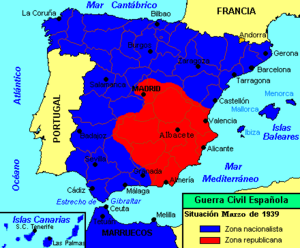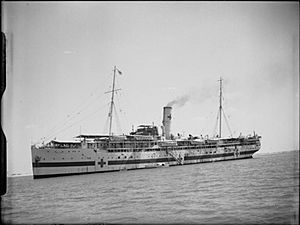National Defence Council (Spain) facts for kids
|
Consejo Nacional de Defensa
|
|
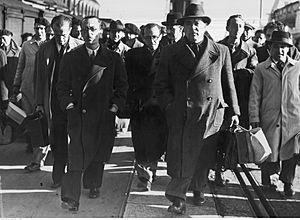
The leaders of the National Defence Council upon their arrival to the United Kingdom: Segismundo Casado, on the left; Wenceslao Carrillo, wearing a hat.
|
|
| Formation | 5 March 1939 |
|---|---|
| Founded at | Madrid |
| Dissolved | 28 March 1939 |
| Type | Governing Council |
| Purpose | Defense of Spain |
| Headquarters | Madrid, Real Casa de la Aduana, Calle de Alcalá |
| Location | |
|
Region
|
Southeast Spain |
|
President
|
José Miaja |
The National Defence Council (in Spanish: Consejo Nacional de Defensa) was a special group that took charge of Republican Spain. This happened at the very end of the Spanish Civil War (1936–1939). The council took power on March 5, 1939. This was after Colonel Segismundo Casado led a sudden takeover. It was clear by then that the Republicans were losing the war.
The council leaders hoped to talk with the rebel forces. These forces were led by General Francisco Franco. They wanted to find a way to end the fighting. But Franco demanded that the Republicans give up completely. On March 26, 1939, he started his final attack. By the end of March, Franco controlled all of Spain. Most council members escaped on British warships.
Contents
Why the Council Was Formed
Even in May 1937, some leaders were looking for peace. Julián Besteiro of the Spanish Socialist Workers' Party went to London. He asked if the British government would help end the war. But he did not get any promises.
When Barcelona fell in January 1939, the situation became very bad. President Manuel Azaña resigned. Besteiro then decided to push for peace. He wanted to remove communists from the government. He believed this would help get support from other countries.
The Federación Anarquista Ibérica (FAI) also wanted a new government. They felt the current government was too dependent on Russia. They wanted leaders who were not blamed for past mistakes.
The fall of Catalonia in February 1939 made it clear the rebels would win. Many people fled to France. General José Miaja, a top Republican commander, asked for permission to negotiate peace. His forces were very weak.
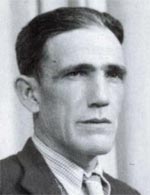
Juan Negrín, the prime minister, returned to Spain. Colonel Casado told him that war material production had dropped by half. There was a big shortage of supplies. Casado said they could not keep fighting. He warned that Madrid would fall, causing many deaths. Negrín agreed the situation was serious. But he insisted they must keep fighting.
Cipriano Mera, another commander, also believed the Republicans would lose. When Negrín refused to surrender, Mera decided to support Casado. They planned to take over the government.
On March 2, 1939, the Ministry of Defense made big changes. General Miaja was moved to a less important role. Some communists were given important positions. Others who opposed communists were moved to minor jobs. People who disliked Negrín said this was proof he was planning a communist takeover. Others disagreed, saying it went against Russia's plans at the time.
This decree became the reason for Casado's takeover. He said it was to stop a communist coup. But Casado had been planning this for months. He had even talked with Franco's supporters. On March 4, 1939, Casado met with Mera and other leaders. They were told that communists planned a takeover for March 6 or 7. So they had to act fast. At this meeting, they chose most of the people for the National Defense Council.
The Coup and New Leaders
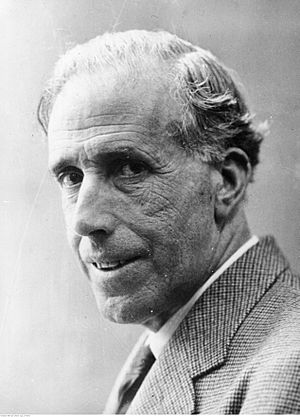
Casado set up his base on Sunday, March 5, 1939. He chose the old Ministry of Finance building. He thought it would be easy to defend against a communist uprising. Most of his fellow plotters joined him by 8 p.m. Besteiro, the most famous person among them, suggested Casado lead the council. Casado agreed to lead only until General Miaja arrived. Mera reached the building at 9 p.m.
The creation of the National Defense Council (Consejo Nacional de Defensa) was announced on the radio at 10 p.m. The names of the council members were read out. They represented most of the political groups that supported the Republic.
Both Besteiro and Casado spoke. Casado claimed that Negrín was planning a takeover by the Communists. The council's goal was to make peace with the rebels. They wanted to end the terrible war. Other members also spoke, explaining the council's aims.
Here were the main leaders of the council:
| Role | Leader | Party | |
|---|---|---|---|
| President | José Miaja | Army | |
| Vice-President and Head of Foreign Affairs |
Julián Besteiro | Spanish Socialist Workers' Party | |
| Head of the Interior | Wenceslao Carrillo | Spanish Socialist Workers' Party | |
| Head of Defense | Segismundo Casado | Army | |
| Head of Finance | Manuel González Marín | National Confederation of Labor | |
| Head of Labor | Antonio Pérez | General Union of Workers | |
| Head of Justice | Miguel San Andrés | Republican Left | |
| Head of Education & Health | José del Río | Republican Union | |
| Head of Communications & Public Works | Eduardo Val | National Confederation of Labor | |
Other important people included Rafael Sánchez Requena and Juan López Sánchez.
What Happened Next?
General Miaja, who was 61, knew he would mostly be a symbol for the council. But with him as president, many army officers accepted the council's power. Prime Minister Negrín did not strongly fight against the takeover. He and his Foreign Secretary left for France on March 6, 1939.
The anarchists (CNT-FAI) decided to work with Casado. This was very important for the coup's success. The anarchist troops, especially those led by Cipriano Mera, helped defeat any resistance. There was fighting in Madrid between Casado's forces and communists. This lasted from March 7 to 12. The communists likely feared being removed from power. Mera's forces were key in defeating them. This fighting cost nearly 2,000 lives.
The council removed the red star symbol from Republican army uniforms. They said it had no military meaning. But the real reason was its link to communism. To save lives, the council allowed Republican troops to leave. They also arranged to evacuate civilians and soldiers from Madrid.
On March 12, 1939, Casado told Franco's government he wanted to negotiate peace. The council had an eight-point peace plan. They asked for forgiveness for political actions. They also wanted time for people to leave Spain. And they asked for respect for soldiers' lives and careers.
On March 18, Besteiro spoke on the radio. He explained the council's efforts for peace. He said they wanted an honorable peace and to avoid more bloodshed. But Franco was not interested in talking. On March 19, Franco replied. He said he would not meet with the Republican officers as equals. He would only accept a complete surrender.
The council also closed down the Servicio de Investigacion Militar (SIM), an intelligence agency. This happened a few days before Franco's forces took Madrid.
On March 23, Casado sent people to Burgos, the rebel capital. Franco still only wanted unconditional surrender. He demanded the Spanish Republican Air Force surrender by March 25. The rest of the Republican forces had to surrender by March 27.
Another meeting happened on March 25. A Republican officer was told the surrender was too slow. When the National Defense Council heard this, they ordered the air force to surrender right away. But it was too late.
Franco had ordered a big attack to start on the morning of March 26, 1939. This was the final offensive of the Spanish Civil War. That morning, Casado sent a message to Burgos. It was not answered.
The message said:
The National Defense Council has done everything possible for peace. It is worried about what might happen if the attack starts. It hopes that damage can be avoided if people in charge are allowed to leave. Otherwise, the Council must fight back.
The council met for the last time on March 27, 1939. That day, the council left for Valencia. Casado told his troops to put down their weapons and not fight the rebels. The next day, Franco's forces entered Madrid.
Julián Besteiro and Rafael Sánchez Guerra were the only council members who stayed in Madrid. They were arrested when Franco's troops entered the city. By March 31, 1939, Franco's forces controlled all of Spain.
After the War Ended
The council members reached Valencia on March 28, 1939. A British consul directed them to Gandia. A British ship was waiting there. But they found many refugees trying to get on the ship. The refugees were told to go to Alicante, where more British ships were said to be waiting.
At dawn on March 30, 1939, Casado and many others boarded the British ship HMS Galatea at Gandia. They were moved to the British hospital ship RFA Maine on April 1, 1939. This ship arrived in Marseille, France, on April 3, 1939. From there, they went to Great Britain.
General Miaja flew from Valencia to Oran on March 30, 1939. He then went to Marseille and Paris. His family had already been exchanged. He sailed with them to Mexico in May 1939. Franco's government punished him with 15 years of exile. He also lost his Spanish citizenship. He died in Mexico in 1958.
Casado was allowed to live in Britain. He wrote a book there explaining his actions. During World War II (1939–1945), he worked for the BBC. After the war, he moved to Venezuela. He returned to Spain in 1961. He was put on trial but was found innocent in 1965.
Wenceslao Carrillo stayed in Britain during the war. He later moved to France. He was a member of the PSOE's executive committee. In his last years, he lived in Belgium, where he died in 1963. Eduardo Val and Manuel González also found safety in England during the war.
Manuel Salgado Moreira also escaped on the Galatea. He was sentenced to death in his absence. He worked as a waiter in a Spanish restaurant in London until he died in 1967.
Julián Besteiro was put on trial on July 8, 1939. He was sentenced to 30 years in prison. He died in prison in 1940.
See also
 In Spanish: Consejo Nacional de Defensa para niños
In Spanish: Consejo Nacional de Defensa para niños


